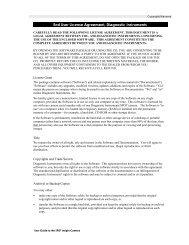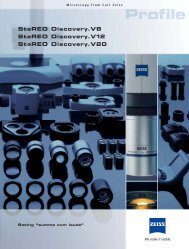optical interference filters - SPOT Imaging Solutions
optical interference filters - SPOT Imaging Solutions
optical interference filters - SPOT Imaging Solutions
You also want an ePaper? Increase the reach of your titles
YUMPU automatically turns print PDFs into web optimized ePapers that Google loves.
Filter Design Considerations<br />
and Your Light Source<br />
Application Note<br />
Overview<br />
Available to system designers today are a wide array of excitation sources. Among the most frequently used are semiconductor<br />
lasers, LEDs (light emitting diodes), arc lamps, gas and solid state lasers, gas discharge lamps, and filament lamps. Each of these<br />
excitation sources have distinct physical and spectral characteristics which make it an optimum choice for a particular application.<br />
In practically all cases however, regardless of which excitation source is selected, the use of a properly designed excitation filter is<br />
required to enhance system performance and optimize signal-to-noise ratio.<br />
While an excitation <strong>filters</strong> role is the same in every system, that is to deliver the desired excitation wavelengths while attenuating<br />
unwanted energy, the characteristics of the filter that achieve these goals are highly dependant on both the source characteristics<br />
and the overall system environment.<br />
– by Mark Ziter, Senior Applications Engineer, Omega Optical<br />
Filters for Gas and Solid State Lasers<br />
Traditionally, gas lasers have been popular excitation sources.<br />
The most common, Argon ion and Krypton ion, provide lines at<br />
488nm, 514nm, 568nm and 647nm. The laser emissions from<br />
these sources are precisely placed, exhibit narrow bandwidths, and<br />
are not subject to drift. While the output of such lasers are usually<br />
thought of as monochromatic, there are often lower energy transitions,<br />
spontaneous emissions, and plasma glow present in the<br />
output, all contributing to unwanted background. A filter to clean<br />
up the laser output and eliminate this noise will greatly enhance the<br />
system’s signal to noise ratio.<br />
Solid state lasers have properties similar to gas lasers. Along with the<br />
well behaved narrow primary laser emissions, these sources produce<br />
background noise from unwanted transitions and pump energy.<br />
Excitation <strong>interference</strong> <strong>filters</strong> for both gas and solid state lasers<br />
share similar design considerations. The narrow bandwidth and<br />
wavelength predictability of these lasers means that <strong>filters</strong> designed<br />
for these sources can have very narrow passband widths. Deep out<br />
of band blocking to attenuate the background is required to ensure<br />
that no unwanted excitation source error energy reaches the detector<br />
and deteriorates the signal-to-noise figure<br />
QuantaMAX Laser Line Filters (see page 57) are ideally suited<br />
to these applications. These <strong>filters</strong>, designated with an XLL prefix,<br />
have high transmission coupled with narrow pass bands, typically<br />
less than 0.4% of the laser wavelength. Manufactured with hard<br />
oxide surface coatings on monolithic high <strong>optical</strong> quality substrates,<br />
they exhibit exceptional thermal stability, shifting less than<br />
a few 1/100th of an Angstrom per deg C. The dense thin film coatings,<br />
deposited by energetic process, are unaffected by environmental<br />
humidity and their ability to withstand high power densities<br />
is unsurpassed in the marketplace.<br />
Filters for Diode Lasers<br />
The output of diode lasers is not as narrow or as precise as the output<br />
of gas and solid state lasers. These semiconductor devices have<br />
bandwidths in the 2nm to 5nm range. In addition, the actual output<br />
wavelength can vary a few nanometers from laser to laser. Compounding<br />
this lot to lot variation is the tendency these lasers have to drift<br />
with temperature and age. As a consequence, semiconductor lasers<br />
have an output wavelength uncertainty of up to +/- 5nm. Therefore,<br />
a diode laser designated as a 405nm device could have an output<br />
anywhere from 400nm to 410nm. Similarly, a 635nm diode laser<br />
may emit as blue as 630nm or as red as 640nm.<br />
Optical <strong>interference</strong> <strong>filters</strong> designed for semiconductor lasers must<br />
be wide enough to accommodate this uncertainty in output wavelength.<br />
Additionally, since a given diode laser will drift with temperature,<br />
any ripple in the filter’s spectral profile will result in an<br />
apparent variation in laser output intensity as the wavelength drifts<br />
across the filter passband.<br />
Both of these considerations have been taken into account in the design<br />
of our XLD (Laser Diode Clean-Up) Filters. See page 54. Similar to all<br />
QuantaMAX <strong>filters</strong>, these are manufactured using ion beam<br />
sputtering to produce stable, dense surface coatings on high <strong>optical</strong><br />
quality substrates. With wider passbands than our Laser Line<br />
Filters, the XLD <strong>filters</strong> will transmit a designated diode laser’s output<br />
across its range of wavelength uncertainty. Their smooth transmission<br />
profiles, with less than +/- 1.5% transmission ripple across the<br />
passband, will not impart variation in laser intensity as the diode<br />
laser drifts with temperature. These <strong>filters</strong>’ deep out of band blocking<br />
will eliminate the secondary emissions that are typical with<br />
semiconductor lasers.<br />
For current product listings, specifications, and pricing:<br />
www.omega<strong>filters</strong>.com • sales@omega<strong>filters</strong>.com<br />
1.866.488.1064 (toll free within USA only) • +1.802.254.2690 (outside USA)<br />
33

















